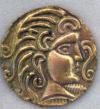Archaeologists Discover Shipwrecks, Ancient Harbor On Coast Of Israel

The discoveries were presented on November 15 and 17 in Chicago at the annual meeting of the American Schools of Oriental Research by URI assistant professors Bridget Buxton and William Krieger on behalf of the Israel Coast Exploration project.
According to Buxton, three of the four well-preserved shipwrecks found off the coast south of Akko were first detected using a sub-bottom profiler in 2011. Later, storms stripped off several meters of inshore sediments and temporarily revealed the wrecks, as well as an additional large vessel. The wrecks are now reburied.
A member of the Marine Archaeology Unit of the Israel Antiquities Authority standing on the ancient quay that was exposed in Akko. In the middle of the picture one can see the floor of the quay, built
During the brief time the shipwrecks were exposed, the Israel Antiquities Authority investigated one of them: a 32 meter vessel which still preserved its brass gudgeon (rudder socket) and many small artifacts, such as plates, a candlestick, and even a cooking pot with bones in it. Laboratory analyses completed this summer by the IAA revealed that the ship’s wood came from Turkey. The team believes these ships may have belonged to the Egyptian navy under Admiral Osman Nurredin Bey, whose ships were severely damaged in his attempt to capture Akko in the Egyptian-Ottoman War of 1831. The town eventually fell to Egyptian land forces under Ibrahim Pasha in 1832.
“These ships have occasionally been exposed and buried again by storms since we found them,” Buxton said. “We’re in a race against time to find other ships in the area and learn from them before storms totally dislodge or destroy them.”
Although shipwrecks from the 1800s are not the highest priorities in a region where civilization goes back thousands of years, Buxton is excited by the discovery for what it tells her about where much older ships may be found.
“Like many underwater archaeologists I’m very interested in finding a well-preserved example of an ancient multi-decked warship from the Hellenistic age,” said Buxton. “These ships were incredible pieces of technology, but we don’t know much about their design because no hulls have been found. However, a combination of unusual environmental and historical factors leads us to believe we have a chance of finding the remains of one of these ships off the northern coast of Israel.”
Buxton believes that the ships they are looking for are likely buried in the coastal sediment, which has built up over the centuries through natural processes. However, time is not on their side. “That protective silt is now being stripped away,” she said. “And it’s being stripped away a lot faster than it was originally dumped, by a combination of development, environmental changes, and the effects of the Aswan Dam.” The Nile River has historically deposited large quantities of silt in the area, but the dam has significantly reduced the flow of silt.
The archaeologists found the ships and another early modern vessel within Akko’s modern harbor while testing their equipment in preparation for an ongoing survey out in deeper water. The sub-bottom profiler detects anomalies below the sea floor. “It’s the gift that keeps on giving,” Buxton said. “We found so many targets to explore that we didn’t have time to check all of them, but even just having information about where things are helps Koby (Jacob Sharvit, director of the IAA Maritime Antiquities Unit) know where to look after any big storms.”
One line of buried targets detected off the southern seawall of old Akko is particularly suggestive. Continuing excavations in this area over the summer revealed an alignment between these targets and a newly-discovered slipway and shipshed structure, which continued out under the sea floor 25 meters from the Ottoman city wall. The feature resembles other naval shipsheds found in places such as Athens where they were used to haul up ancient warships. The excavation project was initially undertaken to strengthen the eroding sea wall, but it also revealed Hellenistic masonry, pottery vessels, an ancient mooring stone, and a stone quay 1.3 meters below the modern sea level. The possibility that much more of the Hellenistic port lies well-preserved under the sea floor is exciting for the archaeologists, because it means that shipwrecks from earlier centuries that have so far not been found at Akko may simply be buried deeper down in the sediment.
“We’ve got fragmentary historic records for this area in the Hellenistic period, and now we’ve found a very important feature from the ancient harbor. Ancient shipwrecks are another piece of the puzzle that will help us to rewrite the story of this region at a critical time in Mediterranean history,” she said.
Located on the northern coast of Israel, the UNESCO World Heritage Site of Akko is one of the few cities in the Mediterranean with more than 5,000 years of maritime history. Also known as Acre, Ake and Ptolemais, its port was an important waypoint for the Phoenicians, Romans, Crusaders, Ottomans and other ancient maritime empires. In the Hellenistic period, it was bitterly fought over by the rival empires of Egypt and Syria.
“Understanding the history and archaeology of Akko’s port is crucial to understanding the broader issues of maritime connectivity and the great power struggles that defined the history of the Eastern Mediterranean during the Hellenistic Age,” Buxton said.
Anyone can join.
Anyone can contribute.
Anyone can become informed about their world.
"United We Stand" Click Here To Create Your Personal Citizen Journalist Account Today, Be Sure To Invite Your Friends.
Before It’s News® is a community of individuals who report on what’s going on around them, from all around the world. Anyone can join. Anyone can contribute. Anyone can become informed about their world. "United We Stand" Click Here To Create Your Personal Citizen Journalist Account Today, Be Sure To Invite Your Friends.
LION'S MANE PRODUCT
Try Our Lion’s Mane WHOLE MIND Nootropic Blend 60 Capsules
Mushrooms are having a moment. One fabulous fungus in particular, lion’s mane, may help improve memory, depression and anxiety symptoms. They are also an excellent source of nutrients that show promise as a therapy for dementia, and other neurodegenerative diseases. If you’re living with anxiety or depression, you may be curious about all the therapy options out there — including the natural ones.Our Lion’s Mane WHOLE MIND Nootropic Blend has been formulated to utilize the potency of Lion’s mane but also include the benefits of four other Highly Beneficial Mushrooms. Synergistically, they work together to Build your health through improving cognitive function and immunity regardless of your age. Our Nootropic not only improves your Cognitive Function and Activates your Immune System, but it benefits growth of Essential Gut Flora, further enhancing your Vitality.
Our Formula includes: Lion’s Mane Mushrooms which Increase Brain Power through nerve growth, lessen anxiety, reduce depression, and improve concentration. Its an excellent adaptogen, promotes sleep and improves immunity. Shiitake Mushrooms which Fight cancer cells and infectious disease, boost the immune system, promotes brain function, and serves as a source of B vitamins. Maitake Mushrooms which regulate blood sugar levels of diabetics, reduce hypertension and boosts the immune system. Reishi Mushrooms which Fight inflammation, liver disease, fatigue, tumor growth and cancer. They Improve skin disorders and soothes digestive problems, stomach ulcers and leaky gut syndrome. Chaga Mushrooms which have anti-aging effects, boost immune function, improve stamina and athletic performance, even act as a natural aphrodisiac, fighting diabetes and improving liver function. Try Our Lion’s Mane WHOLE MIND Nootropic Blend 60 Capsules Today. Be 100% Satisfied or Receive a Full Money Back Guarantee. Order Yours Today by Following This Link.






